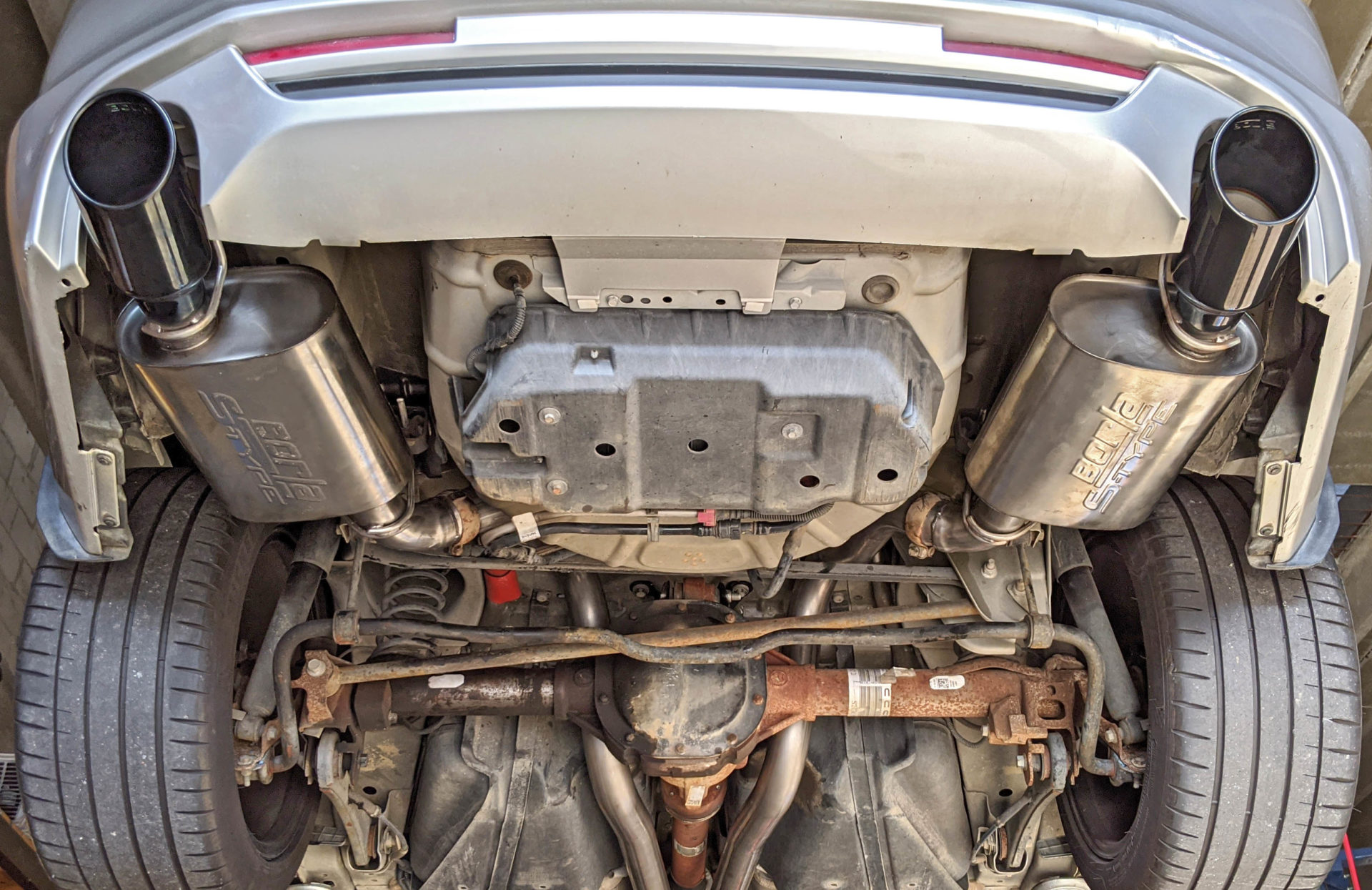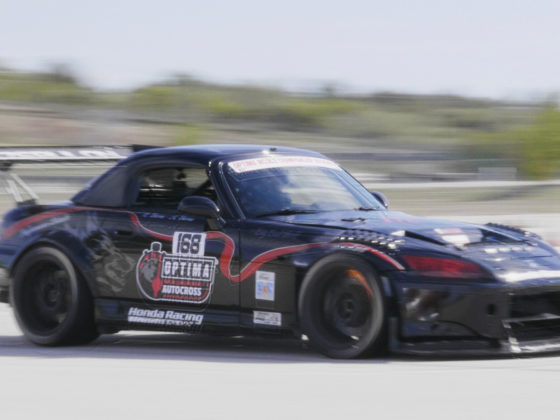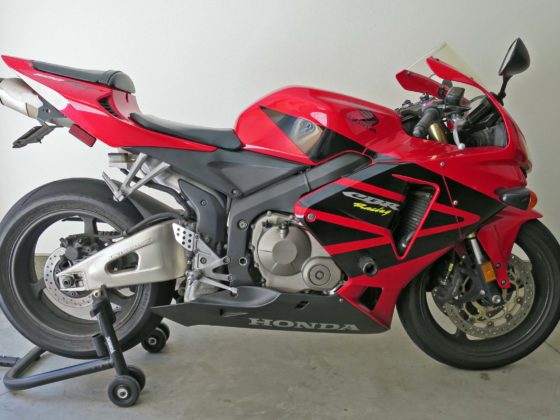 We will retain the stock catalytic converters for the time being, but the 2-bolt flange and ball-clamp make it really cheap and easy to swap out the cats for straight pipes in S197 Mustangs.
We will retain the stock catalytic converters for the time being, but the 2-bolt flange and ball-clamp make it really cheap and easy to swap out the cats for straight pipes in S197 Mustangs.
Newer Gen 2 & 3 Mustangs have the cats integrated into the exhaust manifold which requires custom welding straight pipes to delete the cats. At this point, most people just replace the entire assembly with extremely loud long tube headers instead. Since even deleting the cats will greatly increase the volume of the exhaust, we don’t have any initial plans to go this route.
 The fist step is to remove the factory “H-pipe”.
The fist step is to remove the factory “H-pipe”.
 With the mid-pipe removed, the stock two-piece driveshaft is now clearly visible. There is a bit of performance to be gained by upgrading to a one-piece aluminum or carbon fiber drive shaft, but there are far more important things from a powertrain and handling standpoint that should take priority for track use.
With the mid-pipe removed, the stock two-piece driveshaft is now clearly visible. There is a bit of performance to be gained by upgrading to a one-piece aluminum or carbon fiber drive shaft, but there are far more important things from a powertrain and handling standpoint that should take priority for track use.
After we cover those, we may revisit the drive shaft, but it shouldn’t be as high of a priority as most people make it out to be. It’s important to realize that one-piece drive shafts often introduce a ton of added Noise, Vibration and Harshness (NVH) that can be difficult and time consuming to reduce, but never eliminate. So keep that in mind when considering going to a one-piece drive shaft.
 Most of the power of the new Borla Cat-Back comes from this section of the exhaust. The smooth mandrel bends of the 304 Stainless exhaust not only improves flow and keeps heat in and exhaust energy up, but replacing the factory “H” crossover pipe with an “X” arguably improves exhaust scavenging and therefore power.
Most of the power of the new Borla Cat-Back comes from this section of the exhaust. The smooth mandrel bends of the 304 Stainless exhaust not only improves flow and keeps heat in and exhaust energy up, but replacing the factory “H” crossover pipe with an “X” arguably improves exhaust scavenging and therefore power.
What’s more likely is the change in location where the two exhausts converge. Moving this point forward or back affects the powerband of the engine and can give the car more top end power or low-end torque. This concept can be viewed like tuning a musical instrument or moving the slide tube of a trombone and its effect on sound.
 It’s interesting to see the use of a flex coupler in the middle of the factory H pipe.
It’s interesting to see the use of a flex coupler in the middle of the factory H pipe.
 The smooth bends of the 2.75” Borla X-Pipe has much better flow than stock.
The smooth bends of the 2.75” Borla X-Pipe has much better flow than stock.
Quick Reference:
Page 1 – Stock Exhaust & Borla S-Type
Page 2 – Stock Exhaust Analysis
Page 3 – Crossover Pipe Removal vs Borla
Page 4 – Mid Pipe & Muffler Removal vs Borla
Page 5 – Borla Installation
Page 6 – Borla Installed
Page 7 – Dyno Borla & K&N Airbox Lid On vs Off
Page 8 – Dyno JLT vs K&N Intake. New PBD Tune Dyno
Page 9 – Dyno Overlays: Stock, Tuned Stock Intake Manifold, 2016 Mustang, 2018 Mustang, 2012 Boss 302, Conclusion




14 comments
Great write up with usable comparisons. Do race mustangs tend to stick with duals or go to single for weight?
The old FR500Cs had dual throttle bodies, but most Mustangs now use single round TBs for simplicity.
Really enjoy your perspective on so many things and this build is enjoyable to follow.
Page three, second paragraph first sentence says intake manifold, but probably meant exhaust manifold.
You got me, I got you 😉
Thanks for the feedback!
Thanks for the articles! Stay safe.
Very timely article for me, as I’ve been looking at 11-14 GTs as a fair weather DD, and part time track car. My brother has 12 Boss, but a TP/Brembo GT fits my needs and budget. Is there a Part 1 posted somewhere?
Thanks for posting. Looking forward to Part 4…
what was the alleged speed for the intake on road lid on test? and what gear?
I used nothing but Borla Exhaust on all the BDX Mustangs we made from 2007 to 2009. Love it. Trivia, in 1988 my Fox was the mule for the 1st Mustang Borla system. Alex borrowed it and I drove his T-bird for about 2 weeks.
That’s really cool historical fact! I have Borla on my Tundra tow vehicle, nice mellow V8 rumble in Touring spec. And got an S-Type coming for my Turbo 4 Camaro 1LE, which needs an exhaust note desperately.
Great information, I own a 2014 GT Mustang that I track 3 to 4 times a year, I have done some suspension and brake mods but no engine mods yet.
Really appreciate how methodical and well thought out all your articles are Billy!
Looking forward to seeing the continued progression of this car. Are you planning to road test the airbox lid comparison as described on Page 7?
Factory exhaust is 409ss not mild steel. Pretty much every factory exhaust since the 90s is 409ss. You will find steel components like flanges and hangers, but piping and mufflers are 409ss. Some later stuff is aluminized coated 409ss like the back half of Mopar exhausts, pickup truck tailpipes, generally anything somewhat visible from the outside of the vehicle.
Long tube headers, albeit expensive, will indeed provide for a substantial increase in RWHP….and RWTQ. You would be up to 450 rwhp with LT’s….and that is a bunch. But that would require either no cats..and an X….or a hi-flow catted X. Then the appropriate mufflers, to tame the noise/any drone. Resonators, just before the rear axle, would also tame noise down, if the mufflers didn’t do the job.
We didn’t want the car to be obnoxiously loud, which long tube headers often do. The car is already borderline with cats and the quietest muffler Borla makes. We are happy with the sound and performance with the current package, meeting our performance goals.